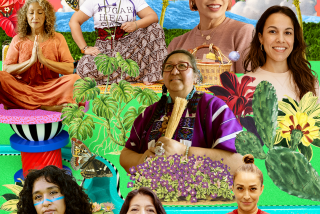Helping People of All Ages to Sleep Like Babies
- Share via
I don’t know about you, but I’m damn happy that Hawaii is a state. You don’t need a passport to have a vacation there, and the tropical wonderland has provided us with a treasure trove of riches. There’s surfing, for one. There’s the macadamia nut, for another, satisfying in its own right, but even better when transmuted into a coffee flavor. Then there’s the pineapple, without which we would not have those many “surprise” desserts.
And there’s Lynne Oyama, best friend to colicky and happy babies alike, and all-around delightful human being. Oyama grew up on a farm on Oahu, the eldest of five children. She helped tend the fields, as well as her younger siblings.
She left Hawaii at age 20, lived in Japan and then returned to the University of Hawaii for a B.A. in psychology. “I wanted to be an art therapist,” she says, “and work with kids.”
She moved to California with her husband, and soon after relocating, they got divorced. “I hadn’t been sleeping well since the divorce,” she recalls. “I started taking massage classes. We all worked on each other. I started feeling better.”
Oyama got a job as a masseuse at LaCosta, then at Two Bunch Palms, a spa in Desert Hot Springs about two hours east of Los Angeles, which is where I met her some time ago.
She introduced me to a form of massage called Trager, a gentle rocking and cradling application that makes the recipient feel like a baby--and sleep like one, too.
“I felt like I had found my life’s work and spiritual path,” Oyama says of the workshop in which she learned the Trager technique. Like all such paths, it has widened and deepened along the way. Nowadays, as Oyama says, “I work on babies of all sizes.”
In addition to helping grown-ups, Oyama, a trained nurse, specializes in craniosacral therapy for infants. While some doctors may be wary of nonconventional treatments, Dr. Judith Brill, director of the Pediatric Intensive Care Unit at UCLA, laments the fact that economics prevents this therapy from being incorporated into mainstream health care. “It’s soothing and healing, but we just cannot afford it,” she says. For the past few years, Oyama has performed her baby body work in Los Angeles. Just what the heck is craniosacral therapy? you may find yourself asking.
The therapy itself, a light, hands-on approach, not exceeding the weight of a nickel, targets the bones in the skull, face, and mouth (the cranium) and down the spinal column to the sacrum. When this system is out of alignment, it can adversely affect the function of the brain and spinal cord, resulting in sensory, motor and intellectual dysfunction, explains Dr. John E. Upledger, an osteopath who has pioneered research in this area.
*
I’m watching Oyama work on a very contented baby. We are in her massage therapy room at the Chapman Child and Family Foundation, a pre- and postpartum care center in Santa Monica where Oyama works when not on duty at Santa Monica Hospital as an RN in the nursery, or the Pump Station, a nearby lactation center where she demonstrates the fine points of infant massage (not to be confused with the craniosacral work that she’s doing in her office right now).
Lisa Glaze has brought her baby Ethan to Oyama for a treatment. He’s 6 weeks old. He had a difficult and long departure from the womb. He had swallowed amniotic fluid. When born, he was jaundiced. He had an asymmetrical jaw, which made it hard to latch on to his mother’s nipple and nurse. There was a lot of spitting up, and early on, a lot of it was blood.
“Birth is the major cause of restriction in craniosacral rhythm,” Oyama says, then to the baby: “Ethan, I’m going to touch you now. Is that OK?” He’s as quiet as a clam as she “palpates” Ethan, placing her hands lightly on his head and stroking, feeling for the pulse of cerebrospinal fluid. “There is an actual out- and-in motion,” she explains. “It is a physical thing.”
This is Ethan’s fourth visit with Oyama. “He’s so much more manageable,” his mother says. “His feedings are more regular.” After applying gentle pressure to various spots, Oyama says that it’s time for Ethan to graduate. Lisa picks him up, and he latches on like, well, a baby. “You know, babies remember birth,” Oyama says. She once asked her then-3-year-old niece what happened when she was born and she said, “I got stuck. It was hard.”
Although easing the suffering of babies is no small thing, Oyama sees this kind of work as something that goes to an even greater problem--the style of giving birth in Western culture. “Dr. Upledger says babies should be pushed out, not pulled,” Oyama says. “There was a study of babies in Uganda, which are born while the mother is squatting, compared to babies in England. The babies in Uganda developed more quickly.”
It’s unlikely that Americans will ever bend to gravity. But Oyama has seen so many infants benefit from craniosacral therapy that it’s clear to her that she’s addressing the consequences of a comparatively violent method of birth. “I feel privileged to work on babies,” she says. “Sometimes they move my hand to the spot where there’s tension. They are telling me what they need.”
*
Patt Morrison is on assignment. Her column returns next month.


